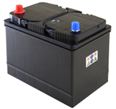Each pre-class Podia question is based on the pre-class material and working through the pre-class material will help you formulate your response. Consider the problem and write down/draw out your solution in your class notebook. These questions are designed to hone your skills so that you can analyze and solve mastery problems you will encounter throughout the course.
Two days before the next whole-class session, the pre-class Podia question will become visible in Podia, where you can click on the prompt and submit your answer.
Submissions for pre-class Podia activities are due 1 hour before the start of your whole-class. Be sure to submit your response before the due time.
Day 42 Pre-Class Podia Activity
 The lead acid battery was developed more than 150 years ago. It is a low-cost rechargeable battery that provides the high current required by automobile starter motors. Lead-acid battery sales account for over 40% of the value from batteries sold world-wide. The following chemical reactions take place in the electrodes of this type of battery.
The lead acid battery was developed more than 150 years ago. It is a low-cost rechargeable battery that provides the high current required by automobile starter motors. Lead-acid battery sales account for over 40% of the value from batteries sold world-wide. The following chemical reactions take place in the electrodes of this type of battery.
PbO2(s) + HSO4–(aq) + 3 H+(aq) ⇌ PbSO4(s) + 2 H2O(ℓ)
Pb(s) + HSO4–(aq) ⇌ PbSO4(s) + H+(aq)
- Assign oxidation numbers to each atom in these half reactions. Complete each of these half reactions by representing the number of electrons consumed or generated in each case.
- Identify which of these reactions takes place in the anode of the lead-acid battery and which reaction occurs in the cathode.
- Draw a schematic diagram of a lead-acid battery cell showing the chemical composition and structure of each half-cell, as well as the flow of electric charge throughout the system.
- The standard reduction potentials in the cathode and anode of a lead-acid battery are E° = 1.685 V and E° = –0.356 V, respectively. Compute the standard cell potential for this battery.
- A typical car battery does not run under standard conditions. The concentration of the sulfuric acid (H2SO4, a strong acid that completely dissociates into H+ and HSO4– ions in aqueous solution) is close to 5 M.
- Write the overall chemical reaction for the lead-acid battery.
- Express the Nernst equation for a lead-acid battery and calculate its actual cell potential at 298 K.
- Express the Nernst equation for the battery as a function of pH (supposing for this exercise that [H+] and [HSO4–] stay equal and change together). Make a graph of cell potential vs. pH and discuss its implications for voltage and power.
Please use this form to report any inconsistencies, errors, or other things you would like to change about this page. We appreciate your comments. 🙂 (Note that we cannot answer questions via the google form. If you have a question, please post it on Piazza.)

